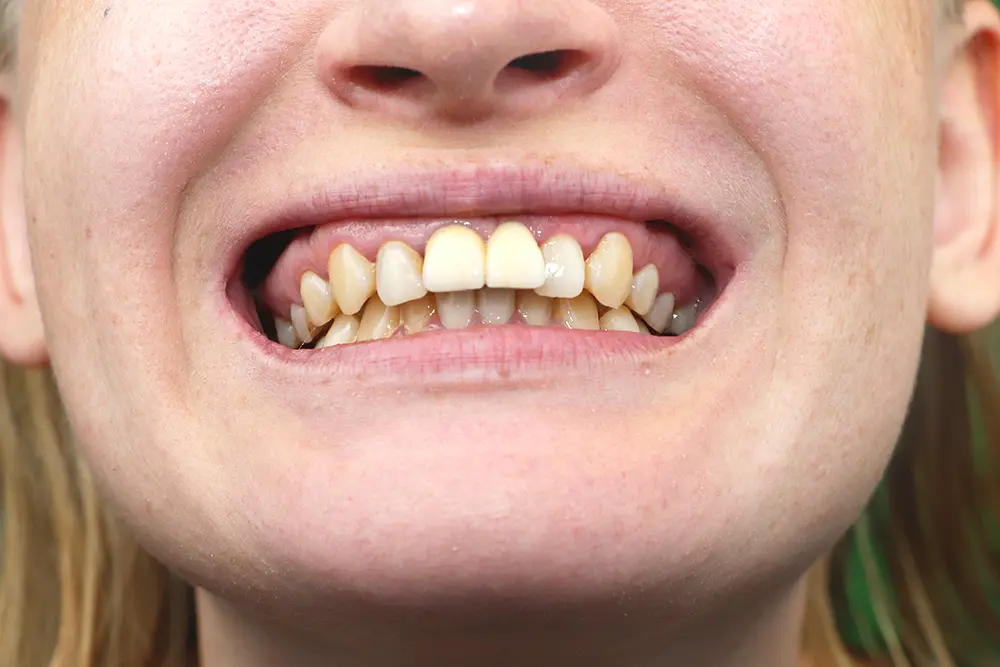
The author of the article
Boris Lipovetskiy, DMD, 31 years experience
Dental implants are the best solution for replacing missing teeth, mimicking both the function and appearance of natural teeth. Despite the high success rates of modern implants, many patients fear surgical procedures and the risk of implant rejection.
In this article, we discuss rare cases of implant rejection, including early signs of development to watch out for and preventive measures. Implantologists from the Advanced Dental Center explore options for re-implantation.
Normal Process of Implant Integration
The integration of a dental implant, or osseointegration, is the process where the implant fuses with the bone. During this process, the hard tissues grow around the implant, eventually leading to its integration into the jawbone.
The process of osseointegration in dental implantation occurs in three stages:
This stage lasts for the first month after implantation. During this period, spongy bone (immature bone tissue with low density) forms around the implant. Therefore, it is not advisable to place a permanent prosthesis at this time.
This stage continues for 4-6 months. The spongy tissue is replaced by lamellar bone, which is secondary (strong and dense bone). It can withstand full chewing loads. At this stage, a crown, bridge, or full prosthesis can be placed.
This stage lasts up to 18 months. During this period, the implant completes its integration and stabilization. After 1.5 years, the risk of implant rejection is minimal.
Before surgery, doctors pay close attention to the condition of the hard tissues. Factors such as bone density and volume play a part in determining the choice of the implant. Even in complex clinical cases, the right implant can be selected for successful integration.
After the implant is placed, bone density increases and bone resorption (breakdown) slows down. If factors such as atrophy are present, that can affect the bone near the teeth. If the implantation is not successful, bone loss accelerates.
What is Implant Rejection?
Dental implant rejection is a pathological destructive process characterized by inflammation, resorption, and loss of the already formed bone tissue that's around the intraosseous part of the implant.
Rejection is a rare phenomenon. According to statistics, its prevalence ranges from 3% to 10%. The rejection rate for zirconium implants is even lower: ranging from 0.5% to 2%.

When an implant fails to integrate, osseointegration does not occur at all. In other words, bone structures do not initially form around the implant. This problem is identified within the first few weeks, at most a couple of months after implantation.
During rejection, the already formed hard tissues begin to inflame and atrophy. This process develops several months or even years after the operation. It is always preceded by specific causes such as mucositis or peri-implantitis.
How Does Implant Rejection Occur?
The timing of implant rejection can be categorized into three periods:
- Early – develops the first days or weeks. This occurs even before the prosthesis is placed. The main causes of early rejection include surgical errors, severe systemic diseases in the patient, and non-compliance with postoperative recommendations.
- Delayed – develops within two years. It is most often due to an improperly fabricated prosthesis, but can also be triggered by excessive chewing loads and poor oral hygiene.
- Late – rejection occurs two years or more after prosthesis placement. It is caused by injuries, newly developed systemic diseases, or hormonal changes.
Even if Implant Rejection Has Begun, It Doesn't Mean the Patient Will Lose the Implant. There are three degrees of mobility in implant rejection:
- Initial. The implant moves in two directions. The amplitude of mobility does not exceed 0.5 mm.
- Moderate. The implant moves in three directions. The amplitude of movement is 0.5-1 mm.
- Severe. The amplitude of mobility in three directions exceeds 1.5-2 mm.
Symptoms of Implant Rejection
In the first days after implantation, patients experience unpleasant symptoms related to the body's reaction to the surgical intervention. These symptoms are normal and gradually subside, disappearing on their own within a week.
However, other similar symptoms can occur with implant rejection. Patients may find it difficult to distinguish between normal postoperative complications and signs of implant rejection. The following comparative table can help:
| Symptom | Normal | Complication |
|---|---|---|
| Pain | Tolerable. Relieved by painkillers. Gradually subsides. | Severe. Does not reduce after taking painkillers. Increases day by day. |
| Swelling | Moderate swelling at the implant site. Sometimes cheek swelling. Subsides within 5 days. | Severe swelling of the gums, cheek, and chin. Swelling does not subside within a week. |
| Bleeding | Moderate for the first 1-2 days. Only blood-tinged exudate is released afterwards. | Moderate to severe. Increases during eating, mouth rinsing, and tooth brushing. |
| Temperature | Up to 38°C. Lasts no more than 3 days. | 38°C or higher. Does not subside, poorly controlled by antipyretics. Persists for more than 3 days. |
| General Weakness | Not severe. Pronounced in the first 3-4 days. | Severe. Weakness and drowsiness increase with each passing day. |
| Bad Breath and Taste | Slight changes in smell and taste. Normalizes in a few days. | Clearly noticeable sweet, unpleasant smell. Taste of metal, pus, or acidity in the mouth. |
| Color and Volume of Gums | Bright red. Clearly defined gum contour around the neck of the implant. | Red, bluish, whitish. Gums recede. Expose the neck of the implant and bone. |
| Pus | None | Present |
| Mobility | Absent | Present |
Symptoms of implant rejection can appear immediately after the surgery, several weeks, months, or even years later. If any of these symptoms occur, contact your doctor immediately!
Causes of Implant Rejection
The main causes of implant rejection are inflammatory and infectious processes. As pathogenic microorganisms multiply, mucositis initially develops – a purulent inflammation without bone resorption. If left untreated, it progresses to peri-implantitis – an infectious inflammation with exposure, damage, and resorption of hard tissues.

Mucositis and peri-implantitis are triggered by many factors, which can be divided into two groups: those caused by medical errors and those caused by improper actions of the patient.
| Errors Due to Implantologist | Errors Due to Patients Actions |
|---|---|
| Failure to follow aseptic and antiseptic rules during surgery. | Smoking. Inhalation of carcinogens and hot smoke burns the mucous membranes, which slows regeneration. Then it reduces blood flow, and tissue nutrition as well as decreases local immunity. Lastly, it accelerates bone loss up to 0.2 mm per year. |
| Violation of the implantation protocol. This can include implanting an incorrectly sized or shaped implant. Aggressive screwing. Overheating the bone during site preparation. | Poor hygiene. Inadequate or untimely cleaning of teeth from plaque and food residues promotes the growth of pathogenic bacteria. This leads to inflammation and suppuration. |
| Insufficient examination, planning, and preparation. The risk of rejection increases if systemic diseases were not identified, bone tissue parameters were not considered, or oral cavity sanitation was not performed. | Excessive chewing loads such as chewing on nuts, chips, rusks. Consumption of steaks, raw vegetables, fruits, and other hard foods in the first weeks after implantation. |
| Damage to the maxillary sinuses, branches of the trigeminal nerve, or blood vessels during implantation. | Refusal to take medications prescribed by the doctor in the postoperative period. |
| Improperly made orthopedic structure. The risks of rejection increase if the crown, bridge, or prosthesis is not custom-made. | Failure to follow restrictions in the first weeks after implantation. For example, engaging in sports, swimming in open water, visiting spas or tanning salons. |
"There are two primary reasons for bone issues after implants. First, the bone may not have completely healed, leaving bad bone or a secondary infection that isn't always visible on regular scans. A 3D scan can reveal low bone density, indicating problematic bone quality and potential implant rejection. Secondly, a traumatic bite or malocclusion can cause bone loss around the implant due to the lack of cushioning ligaments. This leads to inflammation and eventual bone collapse. Ensuring balanced occlusion and using a night guard or orthotic guard is crucial for maintaining implant stability."
Rejection can also occur due to reasons beyond the control of the doctor and patient. These are typically oral diseases and systemic pathologies, which are relative or absolute contraindications for implantation.
Additional causes of implant failure include:
-
Bruxism
-
Malocclusion
-
Temporomandibular joint dysfunction
-
Periodontitis
-
Osteoporosis
-
Hormonal changes
-
Insufficient bone volume or inappropriate bone density
-
Facial injuries
The risk of complications at Advanced Dental Wellness Center is minimal. We conduct thorough diagnostics of patients before surgery, selecting the type of implant individually based on the specific clinical case. We strictly follow implantation protocols and use the best modern implants – zirconium implants. They have an almost zero probability of causing allergies, inflammation, infection, and rejection.
What to Do if an Implant is Rejected?
Implant rejection does not always present with evident symptoms. Therefore, if you notice any concerning signs, you should immediately contact the surgeon who performed the implantation. The surgeon will determine whether the symptoms are due to implant failure or other causes.
Before visiting the doctor, you can do the following at home:
- Take a nonsteroidal anti-inflammatory drug (NSAID).
- Apply a cold compress to the cheek for 10-15 minutes.
- Rinse your mouth with an antiseptic solution.
- Take an antipyretic if you have a fever.
It's important not to take NSAIDs or antipyretics for an extended period. They should be taken once to alleviate symptoms until you can see the implantologist.
It is also dangerous to take antibiotics without a doctor's approval. Uncontrolled use can obscure the clinical picture but will not eliminate the infection.
Diagnosis
For patients showing signs of implant rejection, a thorough diagnostic process is conducted:
- Assess the condition of the gums, checking for inflammation, swelling, and mucosal color.
- Evaluate the state of bone tissues visually and with X-rays.
- Determine the mobility of the implant.
- Check for the presence or absence of pus around the neck and body of the implant.
- Palpate the submandibular lymph nodes, which may be enlarged if an infection is present.
Based on the diagnostic results, the exact cause of pain and inflammation is identified, and a treatment plan is developed.
How to Restore a Dental Implant After Rejection
Treatment strategies for implant rejection vary significantly, and removal is not always necessary. Even if the implant must be extracted, in 80% of cases, it can be replaced with a new one.
The specific treatment plan depends on the condition of the surrounding tissues:
-
If only the superficial layers of the periodontium are affected.
The implant cover screw is removed and cleaned. The gums are disinfected. The screw is reinserted. Antiseptic rinses and antibacterial applications are prescribed.
-
If inflammation has spread to the deep periodontal tissues.
The gum is incised. All infection foci and granulations are removed. A course of antibiotics is prescribed.
-
If the infection has spread to the bone tissues.
The implant is unscrewed. Affected hard and soft tissues are excised. The wound is disinfected. Anti-inflammatory and antibacterial medications are prescribed. After the inflammation subsides, artificial bone material is grafted. Immediate re-implantation is performed, which allows the patient to receive new teeth in one day.
-
If the purulent process has affected the deep layers of the periodontium and periodontium, with noticeable bone loss.
The implant cannot be saved, it will be removed, and antibiotics are prescribed. Guided bone regeneration is performed and a new implant is placed after 2-6 months.
The possibility of re-implantation depends on the reason the implant was rejected. Re-implantation is not advisable if the implant failed due to smoking, poor oral hygiene, or non-compliance with postoperative restrictions. Additionally, the procedure is not performed if systemic diseases, allergies, or critical jawbone atrophy hindered osseointegration. In other cases, the success rate of re-implantation is high.
Prevention of Implant Problems
The success of implant integration depends as much on the patient as on the doctor. You can significantly reduce the risk of rejection by following postoperative recommendations:
- Quit smoking. Smoking regular cigarettes, electronic cigarettes, and vapes increases the risk of implant failure fivefold.
- Take prescribed medications. After implantation, the doctor will prescribe antibiotics, anti-inflammatory drugs, painkillers, and other necessary medications. They prevent complications and ease the postoperative period. Do not change the dosages yourself, and do not interrupt the course of treatment.
- Follow a gentle regimen. In the first few weeks after implantation, reduce physical activity. Avoid lifting heavy objects, engaging in sports, and prolonged sun exposure. As well as, visiting tanning salons, spas, or saunas, and swimming in pools or open water. It is advised to take showers instead of baths.
- Stick to a diet. In the first few weeks, avoid hard foods to reduce chewing load and prevent implant overload or displacement.
- Maintain strict oral hygiene. Use mouth rinses after every meal. Clean your teeth and tongue twice a day with a soft-bristled brush and low-abrasive toothpaste to avoid damaging the gums, mucous membranes, and the operated area.
- Replace dental floss with a water flosser. Floss can easily damage the gum around the implant. A water flosser is a better option, as it thoroughly cleans interdental spaces of food residues and plaque.
- Undergo professional hygiene. Have an ultrasonic teeth cleaning every six months at a dental clinic. This procedure removes bacterial plaque and helps prevent inflammation and infection.

After implantation, your doctor will create an individualized appointment schedule. During these visits, the doctor will evaluate how well the implant is integrating at each stage.
Do not skip preventive check-ups. Early detection of problems allows for timely and conservative treatment of complications.
FAQ
At least 10 years. The best global manufacturers (e.g., from Switzerland, Germany) provide a warranty of 15-20 years for their implants. With proper care, implants can last a lifetime.
Sources of information
- The Etiology and Management of Dental Implant Failure: A Review. Shraddha P. Kochar, Amit Reche, Priyanka Paul.
- Implant Surgery Complications: Etiology and Treatment. Misch, Kelly; Wang, Hom-Lay. Implant Dentistry 17(2): p 159-168, June 2008.
- Immunological Aspects of Dental Implant Rejection. Milad Baseri, Faraz Radmand, Reyhaneh Hamedi, Mehdi Yousefi, Hossein Samadi Kafil.
- Why Are Implants Failing? Gordon J. Christensen.
- Long term clinical result of implant induced injury on the adjacent tooth. Yang-Jin Yi, In-Woo Park, Jeong-Kui Ku, Deuk-Won Jo, Jung-Suk Han, Young-Kyun Kim.



